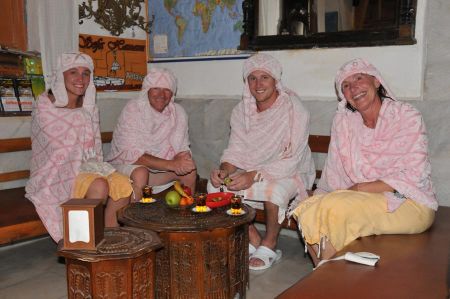Oriental bathing culture in the Sefa Hammam Antalya
- Written by Portal Editor
In addition to the Romans, the Seljuks and a little later the Ottomans also developed a distinctive bathing culture when they began to settle down when they entered Anatolia.
While for the Romans the search for pleasure during the bathing fun in addition to the actual body cleansing came to the fore, for the Ottomans it was more religious aspects. Especially in the Arab world and in today's Turkey, the hammam is also an important part of Islamic bathing and body culture, because thorough washing should be carried out according to the Islamic law of cleanliness, just as before prayer and after sex. Nevertheless, the Ottomans also appreciated the social get-together in the hammam and thus used the bath as a meeting place for topical discussions, which applied to both men and women.
Physical well-being and cleanliness
The oriental bathing culture had its origins centuries ago in the greater Istanbul area and in central Anatolia, where the oldest hammam in Turkey are also located. For Antalya, the Sefa Hamam probably dates back to the 13th century as the city's oldest hammam. The word hamam, which comes from Arabic, means "warming, bathing", colloquially stands for terms such as relaxation, physical well-being and cleanliness.
Usually recognizable from the outside by the shape of the building, the hammam consists of several rooms, the center of which usually consists of a large roof covered with a cupola vault, in the middle of which the navel stone is located as a lying area (Göbektasi). This lying surface is heated from below, is almost always made of marble and is used for physical relaxation before the actual cleaning procedure. Marble benches are usually built around them, on which there are sinks with hot and cold water. While resting on the Göbektasi, you can pour cold or warm water over each other, which is also supposed to help you relax. But let's go through the rooms one by one, because the top priority in every hammam is rest, serenity and enough time for all processes if it is to lead to real relaxation.
Moderate temperature between 40 - 50° Celsius
After entering a hammam, you usually find yourself in a kind of waiting room that is furnished with a seating area or cushions. Here, the welcome is usually given by the lifeguard, who is referred to as Tellak. Often there is also a first tea, so that when the door is closed, all worries and needs symbolically remain outside in front of the hammam. A brief introductory report from the lifeguard is usually followed by instruction in the changing rooms, which, like all other rooms, are usually strictly separated for men and women. The clothing, shoes and bags remain here, so that you are only led to the showers and then to the large relaxation room with the navel stone with only the bath towel, the pestemal and the bathing shoes. Here the length of stay is at your own discretion with rest on the marble benches or the Göbektasi. Relaxation is the goal, to which the moderate temperature between 40 - 50° Celsius contributes.
After this rest phase, the actual washing and cleaning by the lifeguard takes place, which is carried out as a kind of body peeling with the help of a special glove, the so-called kees, usually made of wild side or goat hair. The lifeguard usually uses an olive soap, which foams vigorously and swells all over the glove and helps to remove the top layers of skin. The body is properly scrubbed, cleaned, stretched and kneaded. Shortly after the start of the wash you can feel the improvement in blood circulation, as waste products and toxins are thoroughly eliminated. The heart and circulation are clearly stimulated, which activates the natural defenses. At the request of the visitor, even a body massage is offered. After this treatment, the skin feels clean and soft, the muscles are loose and relaxed. The remaining foam is removed with a water jet and the hair is washed.
Cemberlitas Hamam and Cagaloglu Hamam
Now it's off to the relaxation room, where you can either just relax or treat yourself to one or two Turkish delicacies. A tea or ayran will always be provided.
In addition to the pure promotion of well-being, the combination of heat, soap and massage relieves muscle tension and promotes blood circulation in the skin, so that one can even speak of a medical effect.
There are smaller or larger hammams in almost every Turkish city, some of them in historically very appealing buildings that are decorated with interesting tile motifs. The marble works are also often real works of art. There are more than 100 hammams in Istanbul, all of which are more or less heavily frequented. One of the most famous hammams in Istanbul is Cemberlitas Hamam and Cagaloglu Hamam, built in 1741 near Hagia Sophia. The Tarihi Galatasaray Bath is made entirely of reddish marble and dates back to 1481.
Due to the popularity of the Turkish hammam, these bathhouses can also be found in the big hotels and now also in many European cities. The relaxing bathing culture is spreading and gaining many new followers. You too?
Please read as well:
